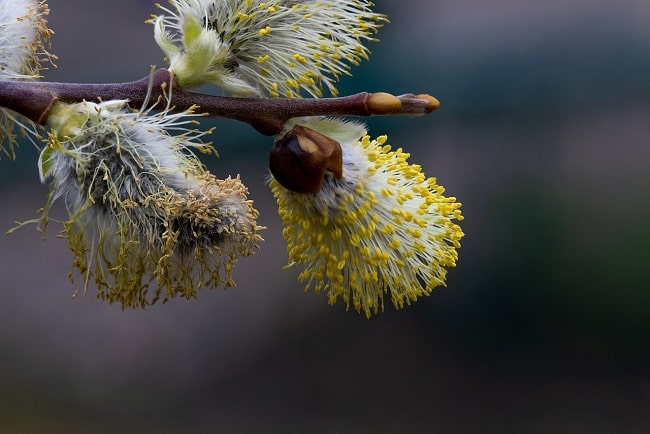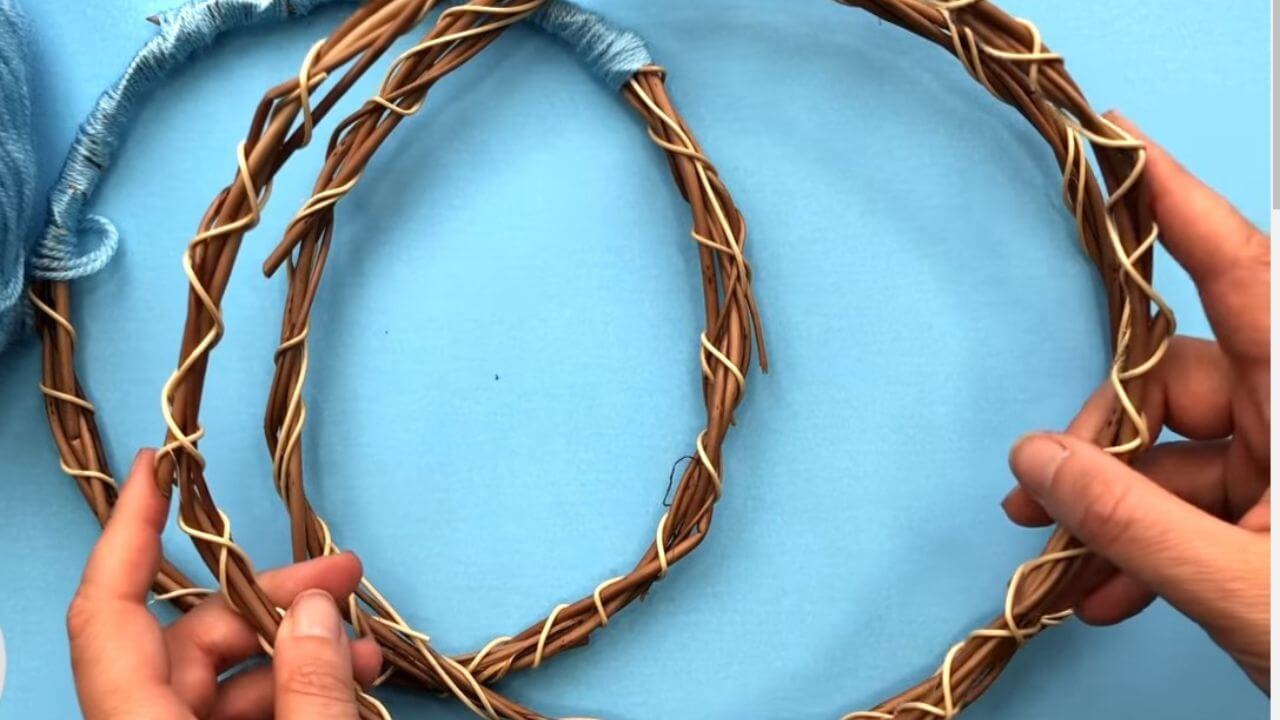Willow branch bending is a centuries-old technique that creates baskets, fences, and sculptures. This ancient art is fun and good for the environment and the bender.
If you want to weave with willow or make other crafts out of willow, you need to know how do you bend willow branches. You can shape willow branches by soaking, steaming, or boiling them.
In this blog post, I’ll talk about the history of willow branch bending, how to do it, and the many benefits it can bring.
No matter how good you are or how new you are to willow branch bending, there is something for everyone to learn and enjoy. So get your clippers and a bunch of willow branches, and let’s start learning how to bend them.
Quick Navigation
Understanding Willow Trees

There are many kinds of willow trees, and each one has its traits. Some of the most common types of willow that are used to weave are:
- Salix Viminalis (Common Osier): This willow has long, flexible branches ideal for weaving baskets and other functional objects. It’s often used for living willow structures such as fences, tunnels, and domes.
- Salix Alba (White Willow):This willow category is stronger than Common Osier and has thicker branches. It is often used to make valuable and artistic things, like baskets, wreaths, and sculptures.
- Salix Babylonica (Weeping Willow): This type of willow is known for its long, drooping branches. It’s often used for living willow structures such as arches and tunnels.
- Salix Caprea (Pussy Willow): Salix caprea, also called “Pussy Willow,” is a type of willow that is known for its extensive, fuzzy flowers, called “catkins,” that bloom in early spring. It is often used to make wreaths and garlands for decorating.
The Best Time To Collect Willow Branches

The best time to collect willow branches for weaving is in the winter or early spring when the sap is low, the bark is easy to peel, and the components are still pliable. Fresh willow branches are essential because they become more difficult to bend and shape as they dry out.
Willow branches consist of several parts used for various purposes in weaving. These include:
- Bark: The bark peeled from the stems and used to create decorative patterns on baskets and other objects.
- Twigs: The smaller branches, or twigs, are used for detail work and adding texture to larger branches.
- Flexible Branches: The flexible branches are used to create the main structure of the object being woven.
- The Base of Branches: The thicker, woodier base of the branches used as a handle or as the base of a basket.
When picking and harvesting willow, you must identify the type and check if it is permitted to harvest. Some willow species are protected or rare, and improper management could harm the environment.
How Do You Bend Willow Branch

Willow branches are used to create baskets, furniture, and other crafts. The flexible nature of willow branches makes them perfect for bending and shaping into various forms. Here is the process of turning willow branches:
Tools and Materials
Here is a list of some standard tools and materials that are used in willow branch bending:
- Willow branches
- Pruning shears or saw
- Soaking container
- Twine, wire, or other binding materials
- Secateurs or sharp scissors
- Gloves
- Water
Each Tool And Material Plays A Vital Role In The Bending Process:
- The willow branches are the primary material and provide the flexibility needed to bend and shape the piece.
- Pruning shears or saws are used to cut the branches to the desired length and shape before soaking.
- The soaking container holds the branches while they soak in water, making them more pliable and easier to bend.
- Twine, wire, or other binding materials are used to secure the branches in the desired shape once they have been bent; this is crucial to keep the branches from returning to their original condition when dry.
- Secateurs or sharp scissors shape the branches’ ends and make cuts or prune them to the desired shape before bending them.
- Gloves help to protect the hands when working with rough bark and potential injuries.
- Water is used to make the branches pliable; plain water or water with added willow bark tea or other solutions to soften the wood.
Some tools and materials may vary depending on the level of complexity, or the type of project, other instruments or materials, such as clamps, pliers, etc., may be helpful.
Preparing The Willow Branches
Preparing the willow branches for bending is an essential step in the process. Here is a general guide for cutting and preparing willow branches:
- Collect The Branches: Collect branches from willow trees in the early spring when the sap is flowing. Look for branches that are flexible and pliable. Avoid branches that are too thick or too stiff, as these may be difficult to bend.
- Measure And Cut The Branches: Use a saw or pruning shears to cut the branches to the desired length. Consider the final size and shape of the object you are creating, and ensure that you have enough branches to complete it. Also, you can prune and shape the branches before bending them by cutting off any unwanted twigs or leaves or shaping the end of the branches.
- Soak The Branches: In water for several hours or overnight to make them more pliable. This is done in a bucket or other container.
- Test The Flexibility of The Branches: Once they are soaked and pliable, test the flexibility of the branches by gently bending them. This will give you an idea of which branches will be easiest to work with and which ones will be more difficult.
- Dry the Branches: Dry off the branches completely to prevent water from interfering with the bending process.
Tips For Choosing Flexible And Strong Branches
Tips for selecting branches with the proper flexibility and strength:
- Look for flexible but not brittle, as brittle branches can break easily.
- Look for branches with a consistent diameter, making it easier to bend and shape them.
- Avoid branches that are too thick, as these may be difficult to bend and may not hold their shape as well.
- Look for branches with smooth, clean surfaces. It may be hard to work on branches with rough or broken bark.
- Test the flexibility of the branches by gently bending them, and you will get an idea of which branches will be easiest to work with.
Bending Techniques
Bending willow branches create various objects, from baskets to furniture. Several methods are used, each with its benefits and drawbacks. Here are three standard bending techniques for willow branches, along with step-by-step instructions and tips for troubleshooting common issues:
1. Soaking And Steaming:
- Soak the branches in water for several hours or overnight to make them more pliable.
- Use a steamer or a pot of boiling water to steam the branches for a few minutes.
- Remove the branches from the water and test their flexibility by gently bending them.
- Begin to turn the branches, working from the unit’s base towards the tip. Use your hands to shape the branch as desired.
- Secure the bent branches with twine, wire, or other materials to hold the shape in place.
- Allow the branches to dry, and the body will be set.
Tips:
- Be cautious not to over-steam the branches as it can make them too pliable and lose their shape while drying if they are not appropriately secured.
- Branches that are too dry or old may not bend as easily as fresh green branches.
2. Bending While Green:
- Collect branches in the early spring when they are green and pliable.
- Cut the branches to the desired length.
- Start bending the branches gently and shaping them as desired.
- Secure the bent branches with twine, wire, or other materials to hold the shape in place.
- Allow the branches to dry, and the body will be set.
Tips:
- You can use a damp cloth to keep the branches moist and pliable while you work.
- Branches that are too dry or old may not bend as easily as fresh green branches.
3. Bending Dry Branches:
- Collect dry branches.
- Cut the branches to the desired length.
- Soak the branches in water for several hours or overnight to make them more pliable.
- Test the flexibility of the branches by gently bending them.
- Start turning the branches gently and shaping them as desired.
- Secure the bent branches with twine, wire, or other materials to hold the shape in place.
Tips:
- Branches that are too dry or old may not bend as easily as fresh green branches.
- Be sure to dry the branches entirely before turning them, as this will prevent cracking.
Note: Depending on the desired outcome, the type of willow branches, and the environmental circumstances, particular projects are better suited to particular techniques.
Troubleshooting Tips For Broken Or Uneven Branches
Regarding troubleshooting, if you encounter issues such as branches breaking or not bending evenly, some possible solutions include:
- Using branches that are the right thickness and flexibility for your project
- Moving slowly and carefully when bending the branches to avoid breaking them
- Using additional materials, such as wire or twine, to help secure the branches and hold their shape
- Ensure the branches are dry enough for bending and not too dry and brittle.
Finishing Touches
When you’re done with your bent willow project, there are a few final steps you can take to make it look nice and make sure it lasts:
- Binding With String Or Raffia: This method can secure and connect the branches, strengthening the structure and giving it an excellent look. A knot was tied around them with twine or raffia to keep the branches together.
- Applying Oil Or Sealant: This is the best way to treat projects that will be outside. By putting linseed oil or a bond on the willow branches, you can protect them from rotting and improve their color and texture. Make sure you don’t use too much oil or sealant, so you don’t damage the branches’ fibers.
- Sanding: You can use fine-grit sandpaper to gently sand the project’s surface to make it smoother and eliminate any rough or uneven spots.
Mistakes That Almost Everyone Makes
Willow branch bending is pleasant and gratifying, but beginners may find it difficult. Common willow branch bending mistakes and how to avoid them:
- Not Soaking The Branches Long Enough: Soaking them for many hours or overnight makes them more flexible. Beginners must soak the branches longer, making them hard to form and breakable. Before bending, soak the branches overnight.
- Bending Too Quickly: Bending too quickly can break willow branches. Bend branches slowly and gently to avoid this mistake. Gradually secure each bend with wire or string before proceeding to the next segment.
- Using The Right Tools: The correct tools can help bend and shape branches. Use bent-nose pliers or a willow-bending tool to avoid this error.
- Not Securing The Branches Properly: Once bent and fashioned, branches must be connected to keep their shape as they dry. Avoid this blunder by securing branches with wire or twine.
- Not Using Enough Wire Or String: Not using enough wire or string to ensure the branches can cause them to slip as they dry. To avoid this mistake, use enough wire or string to tie the branches and carefully bind all joints.
How To Take Care Of A Bent Willow

Taking care of a bent willow project is essential to ensure it lasts. Here are some tips for properly caring for bent willow projects:
- Keep Them Dry: Bent willow projects are susceptible to rotting and decay if left in damp conditions. Keep the project indoors or in a dry, shaded area to protect it from the elements. If the project is exposed to rain or other forms of moisture, make sure to dry it thoroughly as soon as possible.
- Use A Sealant: To protect the willow from decay, you can apply a natural oil such as linseed oil or a bond. This will enhance the color and texture of the branches and keep them from drying out and cracking. Be sure to apply the oil or sealant sparingly so as not to damage the fibers of the branches.
- Regular Maintenance: Willow projects require occasional maintenance to keep them in good condition. This can include tightening loose wires, fixing broken or damaged branches, or replacing missing parts.
- Watch For Signs Of Damage: Bent willow projects can warp, crack or split over time. These issues can occur due to improper storage or exposure to the elements. To prevent this, store the project in a dry area and check it regularly for signs of damage.
- Repair: If you detect damage in the project, repair it as soon as possible. This can include re-securing bent branches or replacing broken sections. Early maintenance is essential because they help prevent further deterioration.
Most Commonly Asked Questions
How Do You Make A Curly Willow Ball?
To make a curly willow ball, you can try the following steps:
- Start with a healthy, flexible willow branch about 3/4″ to 1″ in diameter. Cut it to the desired length, and remove any leaves or twigs.
- Soak the willow branch in water for at least 2-3 hours to make it more pliable.
- Start wrapping the willow branch around itself in a tight spiral, using wire to hold the twists in place as you go.
- Continue wrapping the willow branch tightly around itself until you reach the end or until the desired size is reached.
- Once the ball was complete, it hung to dry for a couple of days. Once dry, the ball will hold its shape.
- You can paint the ball with a coat of sealant if you want.
How Long Will Willow Branches Last?
The longevity of willow branches depends on various factors, such as the type of willow, the environment, and the way the branches are stored or used.
Fresh-cut willow branches can last up to 2 weeks in a vase with water, which is changed regularly and kept in a cool place from direct sunlight.
If the branches are dried properly, they can last for months or even years. Dried willow branches are used for decorating and crafts, as they retain their shape and color.
If the branches are used for living sculpture, or tree shaping depends on the type of willow, some willows are flexible and trained and maintain their shape for a long time, and others will dry and lose their flexibility; the longevity also depends on the method of training and maintenance used.
Which Wood Is Best For Steam Bending?
Different types of wood have other properties that make them more or less suitable for steam bending. Some woods that are commonly used for steam bending include:
- Oak: Oak is a hardwood known for its strength and durability. It is frequently used for steam bending because it is strong enough to hold its shape when bent and is less likely to crack.
- Ash: Ash is a hardwood similar to oak in terms of strength and durability. It is also commonly used for steam bending because it is easier to turn and less likely to crack.
- Maple: Maple is another hardwood that is widely used for steam bending. It is vital, dense, and takes a fine finish.
- Hickory: Hickory is a complex, heavy, and strong wood, it is also a good choice for steam bending because it is strong and takes a fine finish, but it’s more brittle than Oak or Ash.
- Bamboo: Bamboo is a natural composite material made of cellulose fibers that are bundled together; it is also a good choice for steam bending because of its flexibility, strength, and environment-friendly.
- Softwoods: While hardwoods are more commonly used for steam bending, some softwoods, such as western red cedar or Sitka Spruce, are flexible enough and can also be used for steam bending.
Can You Use Weeping Willow For Weaving?
It is possible to use weeping willow branches for weaving, but there are better material choices, depending on the project. Weeping willow branches are pliable and easily bent and shaped, making them well-suited for basket-weaving and other similar crafts.
However, because the branches are relatively thin and brittle, they may not be as durable as different types of wood and may break more easily under stress. Additionally, depending on where you live, it might be illegal to cut down willow trees because it could affect water tables.
Where To Buy Willow Branches For Weaving?
Willow branches for weaving are purchased from several different sources. Some options include:
- Nurseries and Garden Centers: Many nurseries and garden centers sell willow branches, sometimes as bare root plants or as live cutting. These branches are suitable for weaving and are harvested from plants when they are dormant.
- Online Retailers: Several online retailers sell willow branches for weaving, including willow farmers and craft suppliers.
- Specialty Stores: Some craft or basketry stores will have willow branches for sale, or they might be able to particular order it for you.
- Harvesting Your Own: You can also gather your willow branches from your property, a local public park, or a nature reserve. Check with the local authorities first if they have rules or regulations before doing so.
- Ask Local Farmer or Willow Grower: You might have a local farmer or willow grower in your area that has willow branches for sale; they usually have a variety of species to choose from and can guide you on how to use the branches for your specific project.
In The End
Bending willow branches is a fun, and rewarding activity used to make many things, like baskets, garden structures, and decorative pieces. This craft requires knowledge of willow tree types and the optimal time to collect branches.
Success requires cutting and soaking branches and utilizing suitable instruments. Understanding requires soaking, boiling, and bending green and dried branches. Long-term projects require finishing and maintenance.

My name is Md Robiul Islam and I’m a plant enthusiast. I like to have a garden and research different plants. I also have an interest in environmental science and would like to work in that field in the future.


